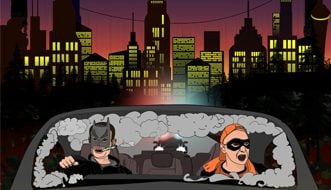
Linton Mill’s ruins in Wharfedale, Yorkshire. When this photograph was taken in May 1985, almost all of the only remaining Woollen Mill in Upper Wharfedale had been demolished, and the chimney only had a couple of days left standing. (Credit: Dr Neil Clifton / The remains of Linton Mill, Wharfedale / CC BY-SA 2.0)
During the first UK coronavirus lockdown in late March 2020, whilst stuck at home and scouring the internet for a heritage fix, I discovered and became inexplicably captivated by the 1979 BBC documentary ‘Fred Dibnah: Steeplejack’. In this award-winning programme, the eponymous protagonist and proud Boltonian single-handedly scales monumental mill chimneys in Northern England via what appears to the untrained eye to be a rickety lattice of wooden ladders lashed together with rope. Inhospitable weather conditions and precipitous drops of several hundred metres or so don’t deter Dibnah from his mission, namely the toppling of what had become redundant components of factory complexes in the rapidly expanding post-industrial heartlands of Lancashire.
Then again, maybe this sudden interest in steeplejacking wasn’t so inexplicable; after all, Dibnah was certainly charismatic, and following his small screen success in 1979, he would go on to either be the focus of, or front, several other acclaimed TV series. Plus, as a millennial I’d only ever known the reassuring embrace of rigorous health and safety legislation. So Dibnah’s dependency on minimal safety equipment, including the use of a flat cap rather than a hardhat, when combined with my own fear of heights, made watching his aerial acrobatics quite an adrenaline rush. Beyond the charisma and vertigo, the film also fascinated me because it provided a snapshot of a period of immense social, cultural and economic change for communities across the north of England in the later part of the 20th century.
In June 2020, all kinds of media were lit up with astonishing footage of the statue of infamous slave trader Edward Colston being pulled down by means of a group of protestors equipped with a combination of sheer determination, solidarity and rope. After many years of pursuing the removal of the statue by complying with Bristol City Council’s protocols and procedures, some campaigners finally ran out of patience when the news of the racist murder of George Floyd, a 46-year-old African American man, in May 2020 in a city several thousands of miles away – Minneapolis, USA – broke.
The townsfolk of Bolton were so chuffed with Dibnah and his achievements, including his chimney toppling exploits, that they posthumously commissioned a statue of him, flat cap ‘n’ all, which was unveiled in the town centre in 2008. However, it was a statue and toppling of an altogether different kind that took place several months after I discovered ‘Fred Dibnah: Steeplejack’ that served as a reminder that erecting statues of engaging TV personalities does not negate the presence of those already in existence dedicated to egregious imperialists.
The brutal killing of Floyd by Minneapolis police officers and the subsequent global protests led by Black Lives Matter emboldened Bristol activists to finally topple the statue of Colston and hurl it into the murky depths of the city’s harbour. Regarding the perceived inaction by Bristol City Council to deal with the statue and what it stood for, to quote a poem that I return to time and again, ‘Naked’, from Professor Benjamin Zephaniah’s 2001 anthology ‘Too Black, Too Strong’, the protestors realised “…that what you can do for me, I can do much better for me…”
With the Colston statue resting and rusting at the bottom of Bristol Harbour and Black Lives Matter protests building momentum around the world, I was invited to respond to this question, as set by Manchester University’s Institute of Cultural Practices online magazine, ‘What Now for Statues with Racist, Colonial, or Imperial Histories?’. I don’t think that my response was particularly radical; all I called for was for museums to be responsive rather than reactive when it comes to the removal or reinterpretation of colonial statues or monuments or the return of ancestors and cultural heritage items taken by colonialists. Reassuringly, this seemed to be in step with the majority of museum leadership teams at the time, who were dispensing anti-racism pledges and promises to ‘do better’ at an unprecedented rate. It remains to be seen how many of these commitments were converted into actual action plans, and how many were covertly abandoned on the bandwagon of social media performativity. Nonetheless, my comments drew the ire of an anonymous Twitter user, who labelled me a ‘misguided wrecking ball’.
Let’s face it, it wasn’t the most hurtful of names; in fact, it sounded vaguely like it could be the name of a contestant on the reality competition TV series that has become compulsive viewing for many of us queers the world over, ‘RuPaul’s Drag Race’. But the accusation of being reckless and indeed feckless is a common one levelled at individuals, communities and organisations involved in confronting the harmful histories and legacies of the British Empire. This work is complex, demanding and at times risky, but it is an absolutely essential part of creating a critical, equitable and representative public memory, and those involved in it, like Dr Sadia Habib and the Manchester-based youth-led Our Shared Cultural Heritage project who delivered the ‘Whose Statues, Whose Stories?’ workshops in 2021, are much more akin to Dibnah’s diligent approach to the dismantling of a mill chimney brick by brick, than anything resembling a ‘misguided wrecking ball’.
Now, I’m not necessarily suggesting that Dibnah or anyone else mentioned in this piece would have supported the removal of the Colston statue. Nor am I endorsing or encouraging anyone else to go around ‘throwing the statue out with the harbour water’, as any number of fulminating cultural commentators that have almost become carbon copies of Steve Coogan’s comic creation ‘Alan Partridge’ may phrase it. But, just as Dinah and his fellow steeplejacks resculpted the skyline of innumerable northern mill towns in response to economic and industrial changes, a comparable cultural, political and societal remoulding of how our colonial histories and legacies are expressed and remembered in our public spaces and institutions is now happening. Much as it wasn’t desirable, necessary or safe for all mill chimneys to be preserved or repurposed, communities around the UK are now taking similar decisions regarding the future of colonial statues, monuments and collections.
In a case of ‘art imitating life’, another award-winning BBC programme, the drama series ‘Waterloo Road’, launched its eleventh series in early 2023 with a riotous episode in which protesting students succeeded in having the name of their secondary school in Rochdale changed from William Beswick High to Waterloo Road High. The inspiration was clear; the fictional Beswick was virtually indistinguishable from Colston, and the private Colston’s Collegiate School had also changed its name back in 2020 to the Collegiate School. Albeit that’s where any similarity between the two schools ends, with Waterloo Road High being much more reminiscent of the comprehensive I attended in my hometown of Skelmersdale. With that, I’ll leave the final word to one of the episode’s protagonists and protest leaders, Samia Choudhry, played by Priyasasha Kumari. Samia captures the zeitgeist perfectly when she demands the removal of a plaque dedicated to Beswick, declaring, “…we won’t back down until that’s taken down…”
Filed under: History
Tagged with: Bolton, bristol, colonialism, Colston, documentary, Fred Dibnah, George Floyd, industrial, Northern England, Statues, steeplejacking



Comments